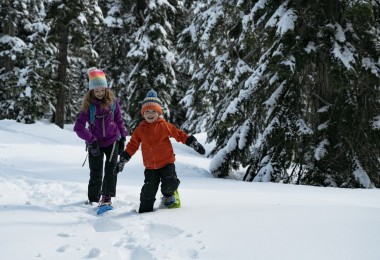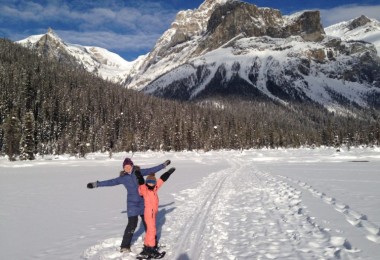One of the best parts of snowshoeing is that it’s a fun activity for the whole family, including pets! Of course, your family can get a good cardio workout and enjoy the winter terrain. But by including your furry friends, you can watch your pet play in the snow and make the snowshoeing experience even more enjoyable. To learn more, we sought out an expert pet lover for more info.
Meet Dr. Heather James, veterinarian and medical director at Feltham Animal Hospital and Central Saanich Animal Hospital in Victoria, BC, Canada. Heather is also a fitness enthusiast and enjoys the outdoors, including snowshoeing in Dakota Ridge and Tetrahedron Range in Sechelt, B.C.
Dr. James shares benefits and tips for bringing your furry friends/family members along on your snowshoeing outings.
Some of the links in this article may contain affiliate links. When you purchase using these links, part of the proceeds go to Snowshoe Mag. Additionally, as Amazon Associates, we earn from qualifying purchases. Please see our disclosure for more details.
Benefits of Snowshoeing With Pets
The benefits of getting on the snow with pets are numerous for our animals and us.
Mental Health Benefits
James began, “There are many health benefits to snowshoeing with your pet.” In fact, the outdoors in winter can be an awe-inspiring place. “Time spent outdoors and with your family (pets included) is good for stress levels,” James continued.
For dogs, snowshoeing provides the opportunity to experience new smells, new sounds, and unique textures. With the change in seasons, these sensors change, which is stimulating for pets. The snow also provides a new environment for play. [For example], there are fresh animal tracks to smell, a bird call overhead, or a stick to play with submerged in the snow.
For people, mental stimulation can be similar. It’s sensory. We can experience the beauty of nature through sound, smell, sight, and touch. We hear the running of a stream, smell the scent of pine, see the colors of the sunset, and feel the crunching beneath our snowshoes. These come together to provide mental health benefits by reducing stress and having fun!
Read More: Snowshoeing Saved My Life
Physical Health Benefits
In addition to the mental health benefits, there are physical health benefits. Snowshoeing is an active sport, and the depth of the snow increases the workout. James says, “The physical exercise will also promote good lean body mass that we know will extend your dog’s healthy lifespan.”
For people, snowshoeing with your pet can help us keep fit too. Pets help motivate us to get out there, despite the weather conditions. James says, “I always say dogs are our best personal trainers as we have a duty to take them out for exercise and play, something we need for ourselves but often goes by the wayside in lieu of other responsibilities.”
Since snowshoeing is a low-impact activity, people and dogs of all ages and abilities can benefit (with a vet/doctor’s approval).
Read More: Winter Athleticism Brings A Healthy Outlook
Companionship
Dogs also can bring people together. As James puts it, “Going snowshoeing with your dog will often lead to invitations for family or friends to go, too, so it is a social time. You will likely meet other dog owners out on the trail. Social interaction is important for both our dogs and us. Your dog will be extra tired from the energy used, so you’ll have a calm evening to relax”.
However, each dog is different, and it’s essential to know preferred interaction levels too. If your dog (or you) doesn’t like interacting with others on the trail, snowshoeing with your dog still allows time for both of you to bond and have fun together.
In a practical sense, pets as a companion can also be a protector and provide support. There are some considerations to snowshoeing alone, and pets can be a buffer for that. In the event of an emergency, having a furry companion with you could end up saving your life.
Tips for Snowshoeing With Pets
James regularly goes snowshoeing with her dog Dottie and shares her tips on snowshoeing with your pet safely and properly.
Get Your Animal Checked
It is recommended to make sure that your dog doesn’t have any significant medical issues, such as arthritis or dehydration before you go trekking in the snow. Especially for longer, multi-day trips, you may want to ask your veterinarian if such a big trip is suitable for your dog.
The other beneficial advice your veterinarian would provide is a list of first aid supplies that you should pack. In addition, many veterinary clinics sell small pet first aid kits that have things you may need along the way.
Stamina for Snowshoeing
Most dog breeds will do well on a snowshoeing trip, although some shorter-legged dogs may struggle more in the deep soft snow. You want to ensure your dog’s stamina fits with the duration of your trip.
Remember that the same distance snowshoeing is not the same distance hiking. Snowshoeing can feel much longer than the same trail in summer since snow is harder to walk in and requires more effort. Larger dogs with good athletic stamina will be great snowshoeing companions.
Read More: Snowshoeing With a Dalmation
Clothing and Feet
Some dogs with very short hair will get chilly in the cold weather. Short-haired dogs may appreciate a jacket (like this one) while out, but not all dogs require one. Short periods in cold weather can help determine your specific dog’s requirements.
Dogs can also be sensitive on their feet or get snowballs in the fur between their toes. If this occurs, you can buy boots from most pet stores. You will want to ensure the boots aren’t on too tight and have a grip on the bottom.
Testing a jacket and boots on short trips in the park or around the block is recommended first. Testing them helps ensure they are the right fit and that no snowballs develop under the jacket or within the boots.
It can be beneficial to put a bell on your dog’s collar for safety reasons so it is easier to find them. Bear or collar bells can be found in outdoor or pet stores. These may also deter wildlife if you’re worried about altercations.
Read More: Dog Days of Winter: Tips for Snowshoeing With Pets
Deep Snow or Trails
Dogs with longer legs can do well in deep snow, but it is certainly more manageable with some snowpack on the trail. In wet snow, you will need to be mindful. As mentioned above, dogs with very soft coats can experience snowballs. Snowballs are where the snow can ball up and become a hindrance. Clipping the hair shorter or putting boots with a grip on the bottom can help prevent snowballs in the fur.
For the first time snowshoeing with your pet, Dr. James says, “[Go] a shorter trip to see if your dog likes the snow and see how they recover after. It is normal for them to be tired after, but you don’t want them to be sore. Just as with a human, you’d want to know you feel fine doing a day trip before you committed to a multi-day trip.”
Read More: Definitive Guide: How To Choose Snowshoes for Your Needs
Nutrition and Hydration
Dry dog food packs well as it is lighter than wet food. You’ll want to encourage your dog to eat regularly, as they will need the energy. Treats can also be helpful to encourage eating or focus your dog’s attention away from hazards like wildlife they may want to chase.
Water is vital to pack! Your pet will need more water to compensate for the losses associated with the high level of exercise. The beauty of snow is that your pet can drink if thirsty. However, you’ll still want to stop regularly to ensure your dog stays hydrated.
Read More: Nutrition for Winter Activities: A Beginner’s Guide
Pet-Friendly Trails/Routes
It’s recommended to look up snowshoe trails in your region for pet-friendly policies. James notes, “You will want to ensure that the trail is dog-friendly and whether they need to be on a leash or not.” Leashing will be mandatory in some areas where you would go snowshoeing, so it is best to look for any posted rules.
James continues, “I prefer dogs to be on a leash if they are prone to running off, as it is likely you’ll see wildlife out on the trail. [However], if their recall is good and you can be certain they’ll come when called, a good run through the snow is a great workout for a dog.” Also, if you are going for a multi-day trip and staying in cabins, research a pet-friendly cabin.
Read More: Gear Review: Howling Dog Alaska Trekking Package
Overall
Taking your pet snowshoeing with you can provide health benefits and companionship for you and your pet. Just remember to follow the tips above for a fun and safe outing. As Dr. James mentions, “Dogs are great companions for snowshoeing as it is great exercise, and they are adorable for snowy photo opportunities. She adds, “When it comes to snowshoeing with your cat, a cat is a great companion for laying on your lap when you get back from your trek.”
What are your experiences snowshoeing with your pet(s)?
This article was first published on October 30, 2019, and Susan Wowk recently updated it on March 16, 2023.
Read Next: Reap the Health Benefits of Snowshoeing









Leave a Comment